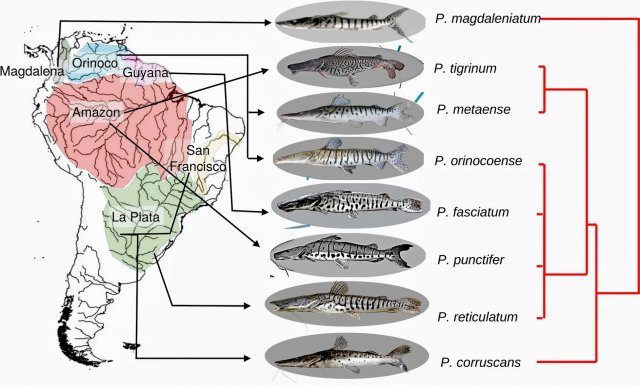Universal model of skin colouration patterns of Pseudoplatystoma
Scarabotti, P., Govezensky, T., Bolcatto, P. & R.A. Barrio. (2020). Universal model for the skin colouration patterns of neotropical catfishes of the genus Pseudoplatystoma. Sci Rep, 10, 12445.
https://doi.org/10.1038/s41598-020-68700-0
https://www.nature.com/articles/s41598-020-68700-0
Abstract
Fish skin colouration has been widely studied because it involves a variety of processes that are important to the broad field of the developmental biology. Mathematical modelling of fish skin patterning first predicted the existence of morphogens and helped to elucidate the mechanisms of pattern formation. The catfishes of the genus
Pseudoplatystoma ', WIDTH, 320)" onmouseout="UnTip()" target="_blank" rel="noreferrer" style="background-color: rgb(235, 234, 221); color: darkgreen; text-decoration: none; direction: ltr; unicode-bidi: embed; display: inline-block; font-weight: bold; font-family: "Lucida Grande", "Trebuchet MS", Verdana, Helvetica, Arial, sans-serif; font-size: 19.76px; font-style: normal; font-variant-ligatures: normal; font-variant-caps: normal; letter-spacing: normal; orphans: 2; text-align: start; text-indent: 0px; text-transform: none; white-space: normal; widows: 2; word-spacing: 0px; -webkit-text-stroke-width: 0px;">Pseudoplatystoma offer a good biological study model, since its species exhibit the most spectacular and amazing variations of colour patterns on the skin. They present labyrinths, closed loops (or cells), alternate spots and stripes, only spots and combinations of these. We have extended a well known mathematical model to study the skin of Pseudoplatystoma. The basic model is a two component, non-linear reaction diffusion system that presents a richness of bifurcations. The extended model assumes that there are two interacting cell/tissue layers in which morphogens diffuse and interact giving rise to the skin colouration pattern. We have found that by varying only two parameters we are able to accurately reproduce the distinct patterns found in all species of Pseudoplatystoma. The histological analysis of skin samples of two species of this genus, with different patterns, revealed differences on the disposition of the colouration cells that are consistent with our theoretical predictions.

Scarabotti, P., Govezensky, T., Bolcatto, P. & R.A. Barrio. (2020). Universal model for the skin colouration patterns of neotropical catfishes of the genus Pseudoplatystoma. Sci Rep, 10, 12445.
https://doi.org/10.1038/s41598-020-68700-0
https://www.nature.com/articles/s41598-020-68700-0
Abstract
Fish skin colouration has been widely studied because it involves a variety of processes that are important to the broad field of the developmental biology. Mathematical modelling of fish skin patterning first predicted the existence of morphogens and helped to elucidate the mechanisms of pattern formation. The catfishes of the genus
Pseudoplatystoma ', WIDTH, 320)" onmouseout="UnTip()" target="_blank" rel="noreferrer" style="background-color: rgb(235, 234, 221); color: darkgreen; text-decoration: none; direction: ltr; unicode-bidi: embed; display: inline-block; font-weight: bold; font-family: "Lucida Grande", "Trebuchet MS", Verdana, Helvetica, Arial, sans-serif; font-size: 19.76px; font-style: normal; font-variant-ligatures: normal; font-variant-caps: normal; letter-spacing: normal; orphans: 2; text-align: start; text-indent: 0px; text-transform: none; white-space: normal; widows: 2; word-spacing: 0px; -webkit-text-stroke-width: 0px;">Pseudoplatystoma offer a good biological study model, since its species exhibit the most spectacular and amazing variations of colour patterns on the skin. They present labyrinths, closed loops (or cells), alternate spots and stripes, only spots and combinations of these. We have extended a well known mathematical model to study the skin of Pseudoplatystoma. The basic model is a two component, non-linear reaction diffusion system that presents a richness of bifurcations. The extended model assumes that there are two interacting cell/tissue layers in which morphogens diffuse and interact giving rise to the skin colouration pattern. We have found that by varying only two parameters we are able to accurately reproduce the distinct patterns found in all species of Pseudoplatystoma. The histological analysis of skin samples of two species of this genus, with different patterns, revealed differences on the disposition of the colouration cells that are consistent with our theoretical predictions.









